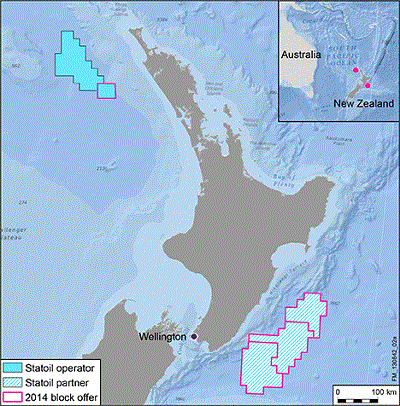Greenpeace NZ Says: "Go Home Statoil"
On Wednesday Greenpeace activists barricaded shut Statoil’s new Wellington office before the Norwegian oil giant has fully opened for business.
And the reason: to send a very clear message to Norway that New Zealanders don’t want Statoil here drilling for deep sea oil, putting our environment and economy at risk, said Nathan Argent, Policy Advisor for Greenpeace New Zealand.
Activists blocked the entry by adding extra locks to the front door and boarding it up with planks and a sign reading ‘Go Home Statoil’. The sign, featuring Maori motifs, was designed by members of Northland iwi that are opposed to deep sea oil exploration off their coast.
The action came a day after New Zealand Energy and Resources minister Simon Bridges opened up new offshore permits. Statoil has picked up four new permits: one off the coast of Northland and three more in the Pegasus Basin.
The Wellington permits are to be shared with Chevron. The company has a disastrous environmental record, says Argent. “Even the government has conceded it’s “not perfect”, which is putting it mildly. Chevron's environmental impact in Ecuador rivals Shells impact in Nigeria.
“Simon Bridges claims that he won’t allow cowboys to operate in our waters. But if it walks like a cowboy, talks like a cowboy, acts like a cowboy and plays fast and loose like a cowboy: It is a cowboy.”
Two weeks ago, Statoil started seismic testing in the deep waters off Northland’s coast looking for signs of oil. To better understand the impacts that seismic testing has on marine mammals, a Greenpeace-sponsored yacht - SV Vega – has set sail to take an independent scientific crew to the zone where Statoil are searching for oil. “It is research that the government failed to do before it started issuing permits to big oil companies like Statoil to come here,” says Argent.
“Oil exploration takes place because oil companies want to drill, which comes with the risk of an oil spill, which would be catastrophic for our coastlines and our local communities. It is a risk we do not need to take.
“New Zealand has a rich history of developing clean energy. We could create many tens of thousands of jobs, give the economy a multi-billion dollar boost and reduce our dependence on oil. The oil industry can’t even come close to matching these figures. And the win-win would be that we play a leading role in delivering the climate solutions that the world needs and at home we will build a cleaner, smarter future for all New Zealanders. So Statoil, please take a hint and go home.”
Yesterday, Oil Free Wellington activists locked themselves to the entrance of the New Zealand Petroleum and Minerals offices to protest against the way oil and gas permits were being distributed.
 The permits see Statoil participating in three blocks in the East Coast and Pegasus basins as a partner, and takes on operatorship for one new permit next to existing acreage in the Reinga basin.
The permits see Statoil participating in three blocks in the East Coast and Pegasus basins as a partner, and takes on operatorship for one new permit next to existing acreage in the Reinga basin.
“The East Coast acreage adds another high-impact opportunity to our long-term portfolio, while the expansion in the Reinga basin secures access to potential upsides from our existing position. This is in line with our exploration strategy of early access at scale and deepening existing positions,” says Erling Vågnes, Statoil’s senior vice president for exploration in the Eastern hemisphere.
Blocks 57083, 57085 and 57087 are awarded with Chevron as operator, both companies holding a 50 percent working interest. The permits are located in the East Coast and Pegasus basins, southeast off New Zealand’s North Island. The permits cover more than 25,000 square kilometres and sit in water depths between 800 and 3,000 metres. The initial phase of the project will consist of data collection.
Block 57057 is awarded to Statoil with a 100 percent working interest. It is located in the Reinga basin offshore Northland, adjacent to Statoil’s existing exploration acreage. The permit covers sits approximately 100 kilometres offshore and covers an area of 1,670 square kilometres in water depths of around 1,500 metres. Statoil has committed to acquire 200 line kilometres of 2D seismic data within the permit.
Statoil entered New Zealand through the 2013 Block Offer, with the award of petroleum exploration permit 55781 in the Reinga basin.
